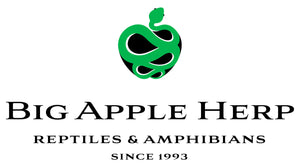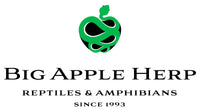Care Sheet For Veiled Chameleons
Without a doubt, the Veiled Chameleon is the most commonly bred and kept species in its genus. There are a number of reasons for this; they are one of the larger chameleon species, quite beautiful, generally hardy and breed relatively easier than many other chameleons. Veiled Chameleons are found naturally in Yemen and the Southern part of Saudi Arabia. Caring for Chameleons in general is considered more advanced than a lot of other reptiles. With this being said, Veiled Chameleons are one of the easiest Chameleons to care for but providing the correct enclosure and following a sound regimen for care is still critical. In addition, unhealthy imported Veils have proliferated the industry so purchasing a Veiled that is healthy and captive bred is of the utmost importance. At Big Apple Pet Supply, all of our Veiled Chameleons are bred in house and we maintain a strict quality control.
HOUSING
Only one Veiled Chameleon should be housed in any enclosure. The recommended size for a Veiled would be something like 30"L x 30"W x 48"H or the same dimensions with 72"H. These are the same size enclosures as our 175 gallon and 260 gallon reptariums which are available in our Cages & Habitats section of our website. If you decide to use something else to house your Veiled you need to make sure that at least two sides of the enclosure are fully screened. Remember that the 4" chameleon we ship to you might become a 12" chameleon in as short as 8 months and then eventually reach the full size of approximately 15" by a year. We'll be happy to set you up with the correct cage, heating, lighting and accessories for your new pet.
Since Chameleons are arboreal it is critical to provide branches throughout the cage that are properly sized. The branches and vines should be slightly larger than your Chameleon's grip. While you do not want to overcrowd the cage with branches and vines you do want to make sure that there is enough branches and vines to let the chameleon go to basking spots and places to perch and eat. To support your system of branches and vines you can use cable/security ties or something like the branch and perch tethers we sell. Some hobbyists find that having a Pothos or or Ficus plant works great as they eat the leaves and like to walk on the plants branches. However, make sure you purchase these plants from a pesticide free store. Items such as branches, vines, etc. can be found in the habitat furnishings section of our website.
SUBSTRATE
We do not recommend the use of wood chips of any kind with Chameleons. Some customers do not use any substrate at all but you may use paper towels, newsprint or similar product. The use of wood chips could be a serious problem if your Chameleon ingests it while gobbling up crickets or mealworms. The chips could become impacted in their digestive system which is a serious situation.
HEATING
As with all reptiles, Veiled Chameleons need a thermal gradient consisting of a warm side (90 Deg. F), basking spot (90 to 100 Deg. F) and a cool area (75 Deg. F). The best way to heat your Chameleon enclosure is with a combination of a heat mat on the floor to raise heat from the bottom up and a ceramic heat emitter. We recommend the Intellitemp Heat Mat and Black Heat Ceramic Infrared Heat Emitter to accomplish the heating of your Chameleon cage. The heat mat and ceramic heat emitter should be located on one side while the other side should not have any heat source. It is a good idea to control the ceramic emitter with a thermostat but make sure to purchase a quality thermometer to keep track of your warm and cool sides. Thermometers and thermostats are available in our heating supply section.
LIGHTING
Veiled Chameleons must have a UV bulb to keep them healthy. We highly recommend a Sunforce UV Mercury Vapor bulb or other brand mercury vapor bulb. Successful UV can be produced with a Zoo Med Reptisun 10.0 bulb as well but your dragon should be within 15 inches of the 10.0 bulb. All of these bulbs can be found in our lighting section of our reptile department. Don't forget that you must change your UV bulb every 6 months in order to maintain proper UVA/UVB.
Humidity & WATER
It is true that Veiled Chameleons typical environment is dry but they do require humidity and water. Veiled Chameleons as babies and juveniles should be misted twice a day so that they can drink from droplets on the leaves around them. As they become adults they can be trained to drink from a bowl but it is recommended that you have branches leaning into or very close to the bowl so that access is easy. In the end, a dripper is an excellent way to provide water to your Chameleon by allowing drops to accumulate on vegetation above the bowl. If it is within your budget, a misting system is the absolute best way to handle the issue of providing water plus it will help keep your enclosure at the 50 to 60 percent that Veiled Chameleons will do well in.
FOOD
Veiled Chameleons are hardy eaters and will typically eat crickets (their staple food), mealworms, giant mealworms, superworms, wax worms and cockroaches. However, Wax worms and mealworms should only be offered as a varied diet because they are high in fat content and can also upset the calcium to phosphorus ratio. Big Apple carries all of the food items Chameleons need in our live feeders section.
VITAMINS
It is important to feed high quality food to your prey items, called "gut loading". The food that is in the prey item's belly is the food that your reptile will be eating. In addition to this you need to coat your crickets, mealworms, etc. with vitamin and calcium powders before feeding them to your reptile. We carry a full line of quality insect food and reptile vitamins and calcium in our Food section.
CAGE MAINTENANCE
Veiled Chameleons require minimal maintenance but you should wash down your cages's floor with Quat Plus (available in our cleaning section) or a mild detergent at least a couple times a week. If using paper towels, change all paper towels at least once a week.
HIBERNATION
Hibernation is NOT natural for Veiled Chameleons in the wild and you should heat your Veiled throughout the winter so that they continue to eat, drink and be active. A general reduction in feeding behavior is normal during winter months due to temperature fluctuations in your house. As long as they keep fairly consistent weight it is generally not an issue and normal feeding typically resume in the spring.


